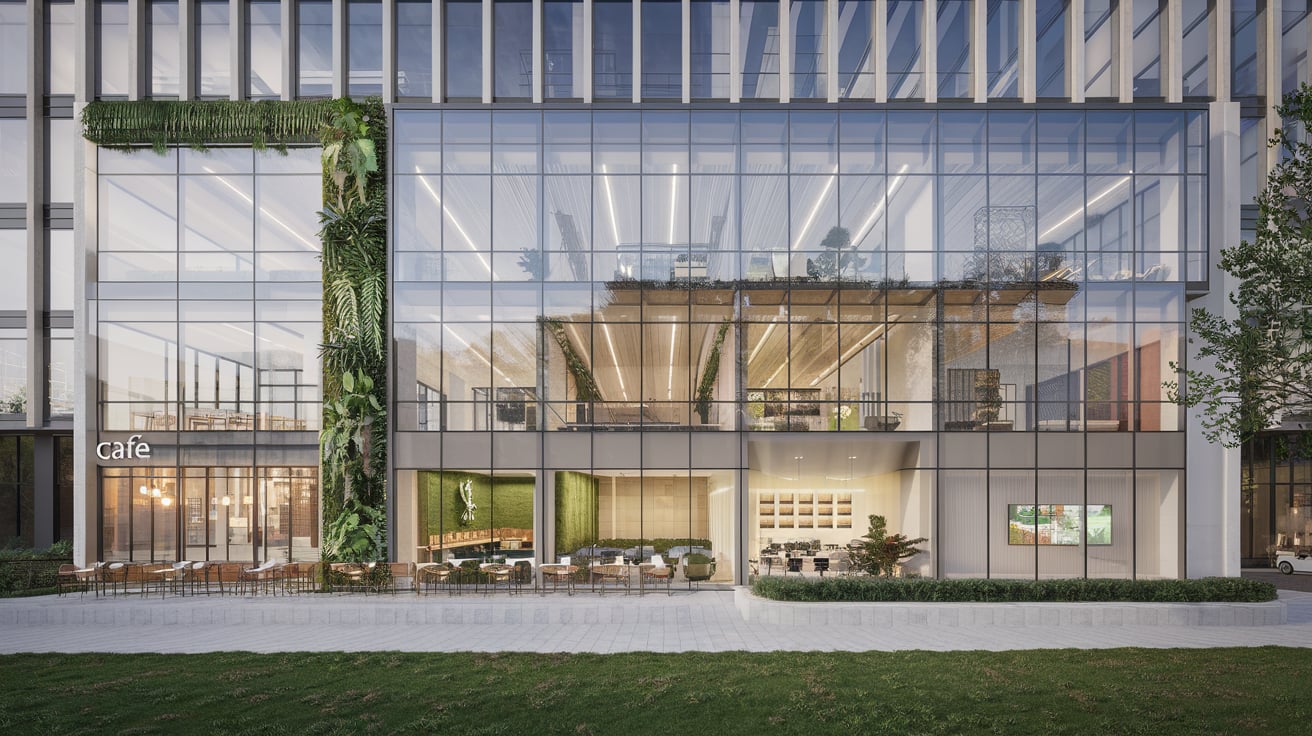It is challenging to create distinctive commercial spaces that stand out in today’s competitive market. Buildings need to be functional and align with brand identity while staying within budget and timeline constraints.
I understand these challenges firsthand, having worked with businesses struggling to translate their vision into architectural reality.
That’s why I’ve developed a process that balances creativity with practicality, ensuring your commercial project makes the right impression while serving its purpose effectively.
In this blog, I’ll share key principles of successful commercial architecture, from why it matters to key elements of effective design, how it affects business operations, emerging trends, and practical ways to overcome common challenges you might face along the way.
Impactful Commercial Architecture
Commercial architecture isn’t just about putting up buildings where business happens. It’s the silent ambassador of your brand, speaking volumes before anyone walks through your door.
When I design commercial spaces, I focus on creating environments that work hard for my clients. A well-designed store, office, or restaurant doesn’t just look good; it actively contributes to business success in several important ways.
- The Importance of Design- Good commercial spaces share thoughtful designs that balance function and feeling. I ask clients, “How should people feel when they enter?” This guides key decisions.
- Creating First Impressions- You never get a second chance at first impressions. I redesigned a law firm’s entrance by using warm lighting, natural materials, and clear signs. Walk-in consultations increased by 30%.
- Optimizing Function and Flow- Great spaces work smoothly. People know where to go without thinking. I fixed a restaurant’s workflow with minor changes, improving service times without major renovation. Small tweaks often make the biggest impact.
- Commercial Architecture in Urban Development- Thoughtful commercial buildings shape neighborhoods. A well-designed project can revitalize areas and create community spots. My mixed-use development in an old industrial area kept original warehouse elements while adding modern retail spaces, sparking neighborhood renewal.
Key Elements of Effective Commercial Architecture
Creating a commercial building that truly works isn’t just about making something that looks nice. It’s about blending several key elements that work together to create a space that serves its purpose brilliantly.
Let me walk you through the building blocks of great commercial design.
Building Materials and Their Influence on Durability
The materials I choose for a project speak volumes about the space before anyone says a word. Each material brings its own personality and practical benefits to the table:
| Material | Aesthetic | Quality | Best Used For | Cost Level |
|---|---|---|---|---|
| Glass | Modern, transparent, bright | Moderate | Storefronts, offices, showrooms | Medium-High |
| Wood | Warm, natural, inviting | Varies by type | Boutiques, restaurants, hospitality | Medium-High |
| Concrete | Industrial, minimalist, strong | Very High | Urban retail, modern offices, industrial spaces | Medium |
| Brick | Traditional, solid, textured | Very High | Historic renovations, craft businesses, restaurants | Medium |
| Steel | Contemporary, sleek, precise | Very High | Modern offices, high-end retail, structural features | High |
Lighting Design and Its Impact on Mood and Productivity
Lighting might be the most underrated element of commercial design. It completely transforms how people experience a space:
| Lighting Type | Mood Effect | Energy Efficiency | Best Applications | Considerations |
|---|---|---|---|---|
| Natural light | Uplifting, energizing | Highest | Offices, retail, restaurants | Glare, heat gain, seasonal variation |
| LED | Versatile, customizable | Very High | All commercial spaces | Initial cost, color temperature selection |
| Task lighting | Focused, productive | High | Workstations, checkout areas | Positioning to prevent shadows |
| Ambient lighting | Relaxing, welcoming | Varies | Hospitality, restaurants, lobbies | Creating even illumination |
| Accent lighting | Dramatic, highlighting | Medium | Retail displays, art, architectural features | Balance with other lighting |
How Commercial Architecture Affects Business Operations?
The buildings where business happens shape how well that business runs. Good design does much more than look nice; it actively supports your operations and bottom line.
Influencing Employee Productivity and Well-Being
The right architectural choices boost how people work. Natural light, good air quality, and comfortable temperatures reduce sick days and increase focus.
Strategic layout design can encourage collaboration through “collision points” where team members naturally interact, sparking innovation through casual conversations.
Maximizing Space Efficiency for Business Needs
Every square foot costs money. Smart design makes that space work harder.
Vertical storage solutions, flexible areas that serve multiple purposes, and thoughtful workflow patterns can dramatically increase efficiency without expanding your footprint.
Designing Customer-Friendly Environments
How customers experience your space directly impacts sales. A well-designed restaurant improves table turnover while making diners feel relaxed.
Retail spaces with intuitive customer journeys naturally expose shoppers to more products, increasing purchase rates.
How the Right Commercial Architecture Attracts Clients
1. Distinctive Exterior Design
- An eye-catching building exterior functions as a powerful marketing tool, distinguishing your business from competitors at first glance.
- Architectural elements like unique shapes, materials, or lighting create visual interest that draws attention, generates curiosity, and becomes memorable to passersby.
2. Welcoming Entrance Areas
- The transition from outside to inside sets the tone for the entire client experience.
- Well-designed entrances with appropriate scale, clear sightlines, intuitive wayfinding, and deliberate lighting guide visitors confidently into your space.
3. Natural Light Integration
- Spaces filled with natural light create environments where people instinctively want to spend time.
- Strategically placed windows, skylights, and glass walls reduce dependency on artificial lighting while improving mood, productivity, and product visibility.
4. Strategic Space Planning
- Thoughtful layouts guide clients through your space in ways that showcase products or services while feeling natural and unforced.
- Careful consideration of traffic flow, focal points, pause areas, and circulation patterns creates intuitive pathways that enhance discovery without frustration.
Practical Solutions for Commercial Architecture Challenges
Practical ways to overcome common challenges in Commercial Architecture often start with clear communication between all stakeholders.
Establishing detailed project requirements and budgets upfront helps prevent costly changes later. When facing strict building codes, work closely with local officials early in the design process to understand limitations and opportunities before finalizing plans.
For sustainability challenges, consider lifecycle costs rather than just initial expenses, as energy-efficient systems often pay for themselves over time. When space is limited, maximize functionality through multipurpose areas and vertical design solutions.
For projects with tight timelines, implement phased construction approaches and use prefabricated elements where appropriate to speed up the building process.
Wrapping It Up
Commercial architecture is more than just bricks and mortar; it’s where form meets function to serve your business purpose. Throughout this blog, we’ve explored how thoughtful design choices directly impact everything from employee productivity to customer experience.
Remember that law firm whose redesigned entrance boosted consultations by 30%? Or the restaurant where simple layout changes improved service times? These examples show how commercial spaces can actively contribute to your success.
The right architectural style, whether open plan for collaboration or closed spaces for privacy, should align with your specific business needs and brand identity.
Frequently Asked Questions
1. What Is the Field of Commercial Architecture?
Commercial architecture is the design of business spaces like offices, retail stores, restaurants, and industrial buildings. It combines function, aesthetics, and brand identity to support business operations.
2. What Is the Highest-Paying Architecture Job?
Principal architects at large firms or architectural directors typically earn the highest salaries, often reaching $150,000- $200,000+ annually. Specialized roles in sustainable design or healthcare architecture also pay well.
3. Is Studying Architecture Hard?
Yes, studying architecture is challenging. It requires creativity, technical skills, long hours in design studios, and the mastery of complex subjects like structural engineering, building codes, and design theory.











One Comment
vavada casino: vavada – vavada